COVER- Jefferson School giveaway: Can Charlottesville get it right this time?
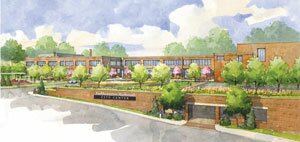
The new-and-improved Jefferson School as seen through architectural renderings.
DRAWINGS BY BUSHMAN DREYFUS
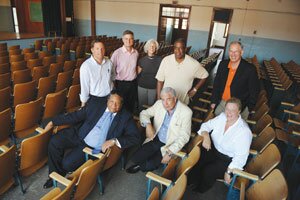
The future owners of the Jefferson School vow that it will be a community treasure. Standing from left are Stonehaus co-founder Frank Stoner, attorney Steve Blaine, former mayor Bitsy Waters, retired State Farm exec Raymond Carey, and Albemarle County Service Authority director/former city manager Gary O'Connell. Sitting from right: Martin Burks, general manager of J.F. Bell Funeral Home and president of the Jefferson School Community Partnership, former city councilor Julian Taliaferro, and Albemarle magazine publisher Alison Dickie. Not pictured: Architecture prof Craig Barton, retired Alcoa VP Earnest Edwards, former city councilor Kendra Hamilton, and architectural historian Genevieve Keller..
PHOTO BY JEN FARIELLO
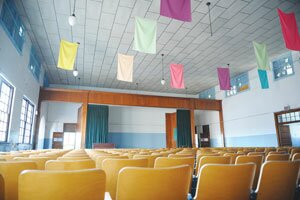
The auditorium is in the oldest part of Jefferson School and will be part of the African American Heritage Center.
PHOTO BY JEN FARIELLO
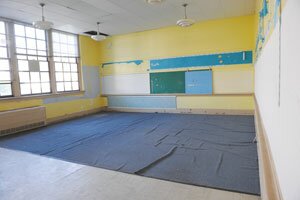
It's been eight years since students attended Jefferson School.
PHOTO BY JEN FARIELLO
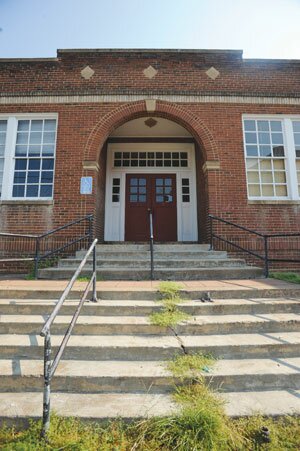
The original front of Jefferson School was on Commerce Street.
PHOTO BY JEN FARIELLO
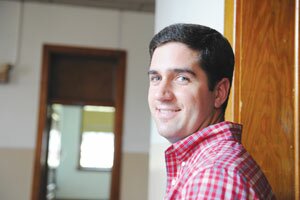
L.J. Lopez with Stonehaus is in charge of turning the dilapidated school into a thriving 21st-century community center.
PHOTO BY JEN FARIELLO
In the center of Charlottesville's most shameful acts from the 20th century sits the Jefferson School. Symbol of segregation? Check. Survivor of Vinegar Hill urban renewal that cleared out an African-American community in the 1960s? Yep. Reminder that Charlottesville closed its schools rather than admit black children during massive resistance in 1958? Right.
Vintage school building falling silently into decrepitude while sitting on four acres of primo real estate, ripe for development? Yes.
But that's where the city and a dozen volunteers say the story veers from historical precedent, that the sale of the property will not be an Omni 2, in which the city pumped over $11 million to private interests.
The story of the sale of the Jefferson School to a group that wants to preserve it as the center of African-American history in the city sounds almost too good to be true, particularly given Charlottesville's history of taxpayer-funded giveaways.
So when the city sells a property valued at $10 million to a private company for the nominal sum of $100,000 (a price actually coming out of nearly $6 million handed to the project from city coffers), how can this be a good deal for the community? The Hook finds out.
Old schools
The former McGuffey School is leased out to artists. The former Lane High School is now known as the Albemarle County Office Building. But the Jefferson School, taken out of service by the city eight years ago, has been sitting empty and in disrepair, except for housing some city maintenance staff and the Carver Recreation Center.
What to do with the Jefferson School is a conundrum that has flummoxed the city for almost a decade.
And to understand why the city rebuffed a plan to sell it to a developer to turn it into condos, it helps to understand the history of the Jefferson School and its predecessors, which date back to the end of the Civil War when the New England Freedman's Aid Society sent teacher Anna Gardner to open a school for former slaves in 1865. That one-room school housed in the Delavan Hospital Unit became the first Jefferson School, according to a report for the National Register of Historic Places. By 1869, a second school was built on West Main near the train depot, and that Jefferson School was one of the earliest public schools in Virginia.
In its third incarnation, the Jefferson Graded School moved to its current location on Fourth and Commerce Streets in 1894. By 1922, the eight-room school was bursting at the seams with 694 African-American students who were not allowed to attend the same schools where white children learned their ABCs, according to the Jefferson School task force report to City Council in 2004.
African-American parents petitioned the Charlottesville School Board to provide a high school for their teenagers, and in 1926 construction began on the Jefferson High School beside the Graded School. Before that, black students had to leave Charlottesville to get a high school education. As for the chance for them to attend Mr. Jefferson's University, that didn't happen until 1950, still more than a couple of decades away.
Newcomers probably know Vinegar Hill as an independent movie theater. They may not realize that where Staples and McDonald's and lots of asphalt are located was once a thriving African-American community with black-owned businesses and its own school. True, its public library was called the Colored Branch Library and was basically the school library with an outside entrance
That was the reality of the Jim Crow era. Everyone who was black went to Jefferson. One of the later additions to Jefferson School was the gymnasium built in 1959, an attempt to demonstrate that poorly funded black schools were "separate but equal." (That notion also spurred the construction of Burley High School on Rose Hill Drive in 1951.)
When Charlottesville closed Lane High and Venable Elementary in 1958 under massive resistance, it was because students from Jefferson School had sued for admission to those white schools in the wake of 1954's Brown v. Board of Education.
And by the time Jefferson School closed in 2002, it stood as a symbol of a long march to equality and to the determination of Charlottesville's African-American citizens to educate their children. But this bricks-and-mortar symbol needed millions of dollars worth of rehab, and that spurred creation of a private group charged with keeping history alive.
The deal
When City Council meets August 16, it will vote to give a second one-year option (the first recently expired) to the Jefferson School Community Partnership LLLP, a private company consisting of 12 citizens that Council asked to buy the school. The second reading of the ordinance allowing conveyance of the historic school was originally set for August 2, but that had to be pushed back because too many councilors were out of town, and selling public property in Virginia requires a super-majority, in this case at least four out of five councilors.
Council City appears ready to throw in another .187 acre from the adjacent City Yard.
"I have full confidence in the people in this partnership," says Mayor Dave Norris, about the group that includes former councilors Kendra Hamilton and Julian Taliaferro. "It's very heartening to see this come together."
Along with the cheapo price tag, Charlottesville also pledges nearly $5.8 million to the Partnership through the Charlottesville Economic Development Authority. The money is ostensibly a loan, although city spokesman Ric Barrick says until the final deal is inked, it would be more accurate to call the money a grant, and it can be used for acquisition of the school, according to the agreement between the city and CEDA.
Why is the city paying a private partnership millions to take a school worth millions?
"Because it makes the project eligible for tax credits," explains Norris. "Otherwise it would cost us millions of dollars to renovate it."
There's widespread agreement that the project would not have been possible without tax credits, those instruments of the large-incomed that can turn, say, a planned super-subdivision named Biscuit Run into a state park.
But tax credits aren't available to nonprofits, and that's why City Council had to ask 12 citizens to form a limited liability partnership. And once the school is sold and the property held for five years, technically there's nothing to prevent the partnership from selling the school, although everyone involved insists that won't happen.
Dan Gecker is widely described as a tax credit expert. A lawyer and Chesterfield County supervisor, he has consulted on projects such as the former Cloverleaf Mall in Chesterfield and on Western State Hosital, a.k.a. The Villages condos, in Staunton, and he helped the Partnership secure $5.76 million from CEDA, as well as a 75,000-square-foot building and 4.1 acres of land. Gecker did not return a reporter's telephone calls.
The option agreement demands the partnership "rehabilitate the structure in accordance with the Secretary of the Interior's Standards for Rehabilitation," a requirement for tax credit eligibility. An African-American cultural center has long loomed large on the wish list for the property, and the city expresses that desire in the sales contract, but acknowledges that the desire is not legally binding.
After the 21,000-square-foot Carver Recreation Center is renovated, the Partnership will lease it back to the city. The Jefferson School African-American Heritage Center gets more than 9,000 square feet, and 21,000 square feet of space will be rented to nonprofits, with the Jefferson Area Board for Aging and the Piedmont Virginia Community College already eager to lease.
The renovation
The $17.3 million project anticipates collecting at least $4.8 million in federal and state tax credits and needs an $11-million loan on top of the city's $5.8 million subsidy, according to a recent presentation to City Council. Architectural plans have been drawn up by Bushman Dreyfus, and the construction will be handled by Stonehaus, a development company whose VP, Frank Stoner, is a member of the Partnership. Everything has been competitively bid, members of the Partnership tell a reporter on a recent tour of the building.
"We're really just trying to cover our cost," says Stoner. "Think of the alternative: the city has to do this themselves using city funds, no tax credits, no community involvement. It would cost $5 to $6 million more. So this it a better deal for the city."
One other consideration: right now, though appraised at $10.8 million, the city collects no property tax from the site. Once it's sold to the Jefferson School Community Partnership, the property is slated to move onto the tax rolls.
The partnership has to hold onto the property for five years to take advantage of the tax credits, and at the end of that time, the company will transfer to the Jefferson School Heritage Foundation, say Partnership members.
Craig Barton is an architecture and urban design professor at UVA, and he's served on the city's Planning Commission and Board of Architectural Review. Like Stoner, he originally got involved as member of something called the Jefferson School Task Force, and he's now one of the dozen soon-to-be-owners. He extols the planned two-level parking garage and dramatic landscaping, not to mention new heating, electrical, and plumbing.
"The site is getting the most dramatic change, mostly from the inside," says Barton. "From the outside, the building will look the same."
Barton, who relishes renovating to federal standards, points to the wooden seats installed in the auditorium in the 1950s. The federal guidelines require that two rows remain, but the rest can be removed to offer more flexibility to the space. Same with the painted-over 1920s windows in the auditorium, which will remain rather than be replaced.
"The demolition here is more surgical," says Barton.
The auditorium is in the oldest section of the school with its original entrance on Commerce Street, and that part will become the Jefferson School African American Heritage Center.
"The Heritage Center is really the anchor," says Barton. "Without it, the project would founder."
Building a Heritage Center
Despite the difficult economic climate and a tourism malaise that has brought attendance figures at such Virginia mainstays as Monticello and Colonial Williamsburg (the latter of which had its worst year in the past 47) down from their historic highs, Andrea Douglas doesn't see any obstacles to creating the Jefferson School African-American Heritage Center.
"I'm a glass half-full person," says Douglas, who's curator of the University Art Museum.
"You've got Monticello writing one part of local history, you've got UVA writing another part," says Douglas. "The African-American cultural center will write the third part. It is an urban story that I feel hasn't been told in an institutional framework anywhere in Charlottesville."
Some artifacts like yearbooks, diplomas, the school clock, as well as issues of the school newspaper, The Jeffersonian, have already been donated. "We're still looking for artifacts," says Douglas. "We hope people will look in their attics."
But the biggest artifact, she notes, is the school itself.
"There's a performance venue that historically was a central venue for the African-American community," she says. "We plan to take advantage of that." She also anticipates partnerships with other organizations in the community.
The Heritage Center isn't just a museum, Douglas points out, but a niche opportunity that may contain a genealogy center as well as classes in visual and performing arts.
"It's not just an exhibition space," she says. "It's a cultural center. We expect it to be extremely viable. It could be the connection between downtown and the university."
The center will be a 501 (3)(c) nonprofit. It has plans to hire a director, curator, and program education person, and while it's received some funding, Douglas says she isn't prepared to talk about its budget.
Legendary civil rights activist Eugene Williams is not so convinced about the viability of the Heritage Center. Unless it's somehow tied to Monticello, the area's biggest tourist draw, he brands it "lip service" to the African-American community.
Monticello, the mountain-top plantation home of Thomas Jefferson, has become a world-renowned cultural site with 452,000 visitors last year. Williams fears that unless the Heritage Center gets linked to Monticello, it's doomed to obscurity–- and economic failure.
Ambitious Richmonders got a taste of that in the mid-1990s when a history center called "Valentine Riverside" opened along the James River at the old Tredegar Ironworks. Despite millions in public and private funding, the experiment ended in a $22 million financial failure when crowds failed to materialize. Williams worries that once the city's population of 40,000 has seen the Heritage Center, traffic could dry up.
"If the African-American cultural center generates no income at all, it will become a liability and converted to something else," predicts Williams. "I can see it with no open hours, no director. It becomes a liability and is turned into something commercial– and it's already zoned for that."
Williams notes the recently approved change in zoning from B-1 to B-2, ostensibly to allow an on-site café, could also allow a switch to full-blown commerce. He derides the "spot zoning" that's historically been done in black neighborhoods, and lists the firehouse, Salvation Army and Noland plumbing as examples of spot zoning on Ridge Street that he feels have damaged the neighborhood.
Douglas, however, portrays the Heritage Center less as a "one-stop venue" and more of a "value-add" to Monticello by telling the story of what happened to those people who were once slaves on the mountain. "They moved down the hill and created Vinegar Hill and Starr Hill neighborhoods," she says.
What Douglas and Williams agree upon: The center has to be tied into the larger community.
"The Jefferson School was at the heart of the African-American community," says Douglas, "and I believe it can be the heart of the greater community."
The art of (understanding) the deal
Turning the publicly owned Jefferson School into the privately owned Jefferson School City Center requires a complicated option, sale, fund-raising, and ongoing operation to make it happen.
What's to prevent it from turning into a commercial project down the road depends only on the word of the people involved. After all, the option agreement about to be inked between the city and Partnership explicitly acknowledges that the city cannot legally require the Partnership to open the Heritage Center.
"I just don't see that happening," says Genevieve Keller, an architectural historian and preservation planner, and one of the Jefferson School 12. As a lifelong Charlottesville resident, she remembers growing up in in a segregated city and watching Jefferson School students walking to and from school because there was no bus.
'We have worked very hard to bring this to fruition," says Keller, who thinks this use of rehabilitation tax credits will serve as a model. "That's innovative," she says, "this public-private partnership."
And the Department of Historic Resources lists other examples of public buildings transformed through private efforts. Kenbridge High School in Lunenberg County is now the Kenbridge Community Center. A private foundation has turned the Workhouse in Lorton into an arts center, and the historic Moton School in Farmville– launchpad for one of the major legal cases that became Brown v. Board– is planning a tax credit project, says Elizabeth Tune at the Department.
"I feel much better about it now that it has evolved," says local NAACP chapter president Rick Turner, who has been involved in strategies for the school since 2002. Turner says he's impressed with the caliber of people on the board of the Heritage Center. "The strongest piece is the cultural component," he says.
Still, some citizens who've been around a long time, like Eugene Williams, call it a "giveaway," and wonder whether local blacks will benefit. And for those who recall the razing of the Vinegar Hill community under the guise of urban renewal, the city's plans for Jefferson School raise myriad questions.
"The city has made numerous mistakes," says Sherman White, journalist with the Charlottesville-Albemarle Tribune, a black newspaper. Mentioning the sales of Lane and Burley high schools to Albemarle County as dubious decisions on par with the city's pledge to give up the right to annexation, White also notes a seeming paucity of black faces at the Charlottesville tourism centers.
"Why is it everything that's good for the African-American community makes money for the white community?" he asks.
However, others reject the notion that the partnership members, citizens invited by City Council to oversee the rehabilitation, will profit.
"The people involved are receiving no return," says attorney Steve Blaine, who has represented developers like Hunter Craig, developments like the Landmark Hotel, as well as wine-development couple Bill Moses and Patricia Kluge. "We are volunteers taking time to oversee this project." Blaine also has spent time serving on the Charlottesville Housing Authority.
"It would be a more interesting story if there was a subplot," Blaine acknowledges. "When you get asked by community leaders, it's hard to say no."
The return, says Blaine, will be a "perpetual community center," and he disputes any notion that the conveyance constitutes a giveaway.
"That question about the partners selling off the property–- well, it stings after two years of busting our butts," says former city councilor and Partnership member Kendra Hamilton, who offers her thoughts on whether the deal is good for the city.
"A good deal for the city would have been selling to Chuck Lewis a decade ago and cashing in on 10 years of tax revenue," she says.
"The reason we've gone through this tortuous process is because a group of little old lady schoolteachers from Jefferson, now in their 70s and 80s, said hold on here–- this is the only place in town remaining where you can tell the story of black Charlottesville, of black folks in Central Virginia and what we went through," Hamilton writes in an email. "In their vision, Jefferson was to be a public trust and a public resource for everybody.
"And that's why the partners are doing this–- you would not believe the hours of work people have put in designing the financing structure, recruiting just the right mix of tenants, not to mention designing the program of activities at the cultural center. Not for hope of personal profit, but because–- for each and every one of us to varying degrees–- these little old ladies... they got to us... But then, that's why we were chosen by City Council rather than another group of folks with a similar skill set–- because we were more likely than another group to 'get it' and commit for the long haul to something that was so abstract but that was also so clearly 'the right thing.'"
#
29 comments
"But tax credits aren't available to nonprofits"
Is that true?
And which tax credits (local, state, or federal)?
Well, non-profits wouldn't have to pay taxes, so they couldn't get credits to offset those taxes, right?
I don't think these tax credits are restricted to use by the entity to which they are awarded. You can sell them.
Thanks Lisa, this is a well researched, fascinating story about an important part of Charlottesville's history. I appreciate the Hook for this type of local reporting; that highlights the connection between the City's past and present.
The cover photo by Jen Farriello, not included above, is one, no one should miss. It is worthy of an award for the stunning composition and lighting. The color tones and serene simplicity are a dramatic counterpoint to the stories buried in the time worn walls.
While this is a better cause than so many of the ideas the City has when it gives away it's land to private uses, I find it just one more slap in the face to tax payers.
When do they get to actually vote in a referendum in what happens to their public property? The taxpayer's property? Instead it's up to a few special interests an their friends on City Council.
what happens if the Foundation is unable to purchase the property at the end of 5 years? what happens if the Jefferson School Community partnership defaults on it's loans? City bailout that they can't afford?
Good point, Mahogoff. Even if local non-profits didn't want to go through all of this work, which is not supposed to benefit the organizers financially, one would think that the 12 organizations could incorporate as a non-profit rather than as an limited liability company.
RENOVATION BUDGET: $17.3 million
CITY GRANT/LOAN: $5,764,425.30
CONSTRUCTION LOAN: $11.5 million
TAX CREDITS: $4.8 million to $5.5 million
So they're taking in $22-23 million and their renovation budget is $17.4 including the cost of the building... where's the other $5 or 6 million going?
The "city" didn't make any mistakes, the "people" running the city and those that voted for them (most of whom are all
DEAD) made mistakes.
It is crazy and unreasonable to expect the current taxpayers to waste money trying to right a wrong when it will do no such thing.
The city should sell the land take SOME of the proceeds and fund an african american cultural center on the downtown mall for the next 20 years. Or purchase a storefront and turn it over with a startup budget.
Vineager Hill was NOT the utopia that people imply. It was a neghborhood comprised of mostly run down properties and struggling businesses that the police abandoned because they were unwelcome.
The city replaced the housing with much better housing and were it not for tax dollars that housing would be now be delapitated too.
No one implied that Vinegar Hill was a Utopia. It was still where people lived and the motivation for 'cleaning it out' was not exactly Utopian either.
These days though it seems like an entire neighborhood is supposed to put up with the shenanigans of a struggling business, and be torn down to accommodate more.
"The city replaced the housing with much better housing" -- Westhaven?! A public housing complex?! Are you high? From the pix I've seen a lot of the housing looked like homes in Starr Hill that are prized by yuppies and selling at prices that would have made their original owners sing hallelujah.
If there is any city owned property that would be an appropriate place to put a YMCA it's there. I wonder why that isn't being considered.
What on earth is the purpose of the Jefferson School African-American Heritage Center anyway? Where will its operating funds come from and who does anyone think would visit it? It certainly won't be tourists. Also, Kendra Hamilton and Gary O'Connell on the same board seems to me like a disaster in the making.
Wow. What a waste of money. Take the money and give it to needy students for scholarships
I swear I'm beginning to think it would cheaper to pay one-time reparations than have
taxpayers paying for this kind of nonsense for all eternity.
I assume that the idea is to renovate the rec center and create space to lease to non-profits. That should subsidize a modest "heritage museum," which most people from the area will visit once as a courtesy. Hopefully, the museum will function more as a community center than an actual attempt to lure tourists and be staffed largely by volunteers.
The way I remember it lots and lots of shantys without indoor plumbing...
We are better off with it gone... including those who loved there...
This project is a perfect example of why we are in such a financial crisis.
Imagine if the city spent the same 17 million on low interest loans for statup business for long time city residents...
Old Belmonter,
I guess we'll remember that when your home is torn down to make one more music venue after the city has destroyed your property values via other music venues and whatever struggling business wants to pretend it's a business.
Many homes in Belmont didn't have indoor plumbing either. Now those same homes do. Somebody built them on there.
Shanties would have made way for better housing once the demand was there for the land, and the housing projects only prevented any business development beyond Gleasons.
It was a project done badly.
"It was a project done badly." -welcome to Charlottesville VA!
On that note, I wonder who of the current city council, other than maybe David Brown, would want to put the former City Manager on that board. I was under the impression that Gary O'Connell was basically forced out of his job as City Manager. Maybe I'm mistaken, and maybe it was part of some deal to get rid of him, but regardless, I'm really surprised to see that he is involved in this project. I'd love to know the real story behind that! The Hook does better than most other local news sources, but C'ville is hurting for some real investigative journalism.
Lacy, Gary O'Connell joined the board while he was still City Manager. The board has existed for a while now.
Isn't this same council looking to buy land (or have they bought it already?) just a bit down 4th St. for a single-resident-occupancy apartment facility? I think they're spending millions to acquire that site while giving this land and building away...
Apparently the facility is already being listed as a historic site worthy of visitation. The Journey Through Hallowed Ground has it listed on their website: http://www.hallowedground.org/component/option,com_jthg/theme,region/tas...
Good god, tear it down, I attended jefferson in the early 70's, it always reminded me of a penitentiary.
@Jamme
Pity that you didn't pick up punctuation then.
"Gecker did not return a reporter's telephone calls." That should be a big frantically waving red flag. The financing expert for this dubious venture is staying mum. My guess is: it can't work. A sham deal: a few well meaning citizens duped into fronting for developers who now will control some valuable real estate. The group will make some well-intentioned efforts, and when that falls through as inevitably it must, and the property continues to deteriorate, the developers will say "well, we tried but I couldn't work so now call in the bulldozers." Some may think that the right result. Maybe it is. But this is yet another give-away of valuable city property, like the coal tower given away for $10,000 to a developer, who did absolutely nothing except resell it to another developer for close to million dollars. That's right, nearly a million dollar profit on a $10,000 investment because of the city was too dumb to realize what it was giving away. Still nothing happening there, other than some murders rapes and suicides. The city gives away property like this, and those who know how to game the system get very very rich.
What the city wants is a Museum of Segregation, on the cheap. Impossible. Hey, not every badly constructed building is worth preserving. Segregation was everywhere--let's just put up historical markers as the Paramount to its credit has done near the Third Street entrance where blacks were admitted to the balcony. An elderly friend who remembers segregation at the old Paramount and who has been going to the Met Opera broadcasts in the restored theater said "I never realized--up in the balcony they had the best seats."
Uncle Sam,
I have been asked many times to run for council. One of my agendas would be to stop the City property give aways to ANY private organization, without a full vote by the entire City. It will prevent the developers from getting into bed with different Councilors, so that the taxpayer loses out.
We have had one disaster after another due to it, with the taxpayer and adjoining residents somehow always picking up the costs to save the developer some money.
Omni Hotel. Pavilion. Meadowcreek Parkway. YMCA in McIntyre. Now the Jefferson School.
I am sick and tired of five people thinking they have the right to put a burden on residents for whatever their pet projects are, with City assets.
There is nothing wrong with what these people envision, but they should have to pay market values, so the developers skulking behind them have to take the full risk.
One way to help that is to force these sales to a City wide vote.
@ Old Timer " We have had one disaster after another due to it, with the taxpayer and adjoining residents somehow always picking up the costs to save the developer some money.
Omni Hotel. Pavilion. Meadowcreek Parkway. YMCA in McIntyre. Now the Jefferson School."
Add to that list the loss of the City owned Reservoir, Dams and Ragged Mt. Natural Area, all worth many hundreds of millions of dollars. The citizens paid for and own all this infrastructure. Why would any councilor in their right mind vote not to maintain it or to destroy it ?
Today (Aug 17) at 12:30pm on WINA AM-1070. Someone from Historical Society is going to talk about the early years of Jefferson School.
I THINK IT WOOD BE A NICE PLACE TO HAVE A HOMELESSS SHELTER WITH A SUBSTANCE ABUSE CENTER IN SIDE OF IT LIKE THE HEALING PLACE IN RICHMOND VA GO TO www.thprichmond.org TO FIND OUT MORE I WAS BORN AND RAISE IN CHARLOTTESVILLE AWARE OF THE SITUATION THERE PLEASE TAKE UDDER CONSIDERATION FOR SOME SPACE IN YOUR PROJECT TO HANDLE YOUR OVERFLOW HOMELESS SUBSTANCE ABUSE PROBLEM YOU HAVE IN THE CITY